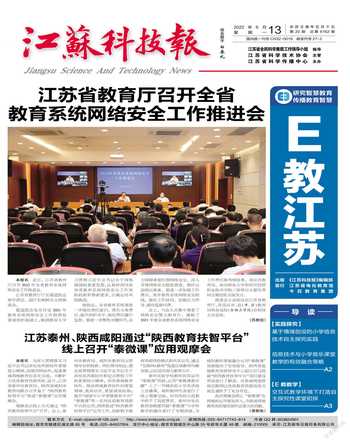Driving K-12 Innovation:2022 TECH ENABLERS(Ⅰ)译题 基础教育创新驱动力报告——2022技术驱动篇(一)

Product by CoSN (The Consortium for School Network)美國学校网络联合会
《基础教育创新驱动力报告》是继《地平线报告(基础教育版)》后推出的国际教育信息化发展的重要参考报告,报告发布方美国学校网络联合会(CoSN)为《地平线报告》发布方美国新媒体联盟的原有合作伙伴,致力于为基础教育及学前领域的教育技术从业者提供团队、知识和专业发展服务,助力创建和发展更有吸引力的学习环境。
2022 TOP 3 TECH ENABLERS
DIGITAL COLLABORATION ENVIRONMENTS
Digital systems, tools, technologies, connectivity, and pedagogy that enable high levels of collaboration and support on line and in-person learning. Digital Collaboration Environments include both synchronous and asynchronous communication tools — platforms that allow multi-user, virtual communications, whether across the room or across the globe. These environments may be tailor-made for education but are often designed for broader use (for example, video call technologies).
UNTETHERED BROADBAND & CONNECTIVITY
Ubiquitous broadband Internet and the underlying technologies that enable robust connected learning – without requiring devices to be physically connected (via cables, for example). These technologies enable mobility and learning anytime, anywhere.
ANALYTICS & ADAPTIVE TECHNOLOGIES
Open digital technologies that collect and use data related to teaching and learning. Analytics refers to the process of analyzing data collected about student learning and the opportunity to leverage data to inform instructional decision making. Adaptive technologies are tools that adapt to the student based on their interactions with the technology. These adaptations could be in the form of suggesting next steps, providing remediation, controlling pacing, or providing feedback based on analysis of the student's performance.
ENABLER
DIGITAL COLLABORATION ENVIRONMENTS
Digital Collaboration Environments have now topped our Advisory Board’s top Tech Enablers list for three years in a row. This long-standing run as a top Tech Enabler reflects how these environments flexibly support teaching and learning and their power to enable agility as schools shift between in-class, remote, and hybrid learning models.
Before the pandemic, there was a long period of growth of alternative learning models that relied on digital platforms. This allowed the use of Digital Collaboration Environments to balloon during the pandemic, as education systems around the globe scrambled to rapidly transition to hybrid or remote learning.
But in order to unleash the full power of these environments, we must focus on collaboration and optimize the experience in the environments. For example, some educators are expanding collaborative scenario-based learning and speculative storytelling using the built-in whiteboard features. Effective collaboration allows educators to facilitate feedback loops, increase engagement, leverage peer interdependence to increase performance, build social skills, and promote higher-level thinking.
These powerful Digital Collaboration Environments will grow evermore essential as the state of the world grows evermore unpredictable.
“When moving to a hybrid or online model, we traveled back in time and used the traditional methods in our online environments, neglecting the methodological innovations. Let’s think ahead and be prepared for any future scenario, not just considering the actual school, but what we think the future of learning will be.”( David Vidal, Seville, Spain)
TIPS & RECOMMENDATIONS FROM THE ADVISORY BOARD
THINK FORWARD FOR YOUR STUDENTS’ FUTURE
“Lean into the future by adopting mindsets and collaborative practices that will build the future-ready learning environments our students need to thrive and face their world with future-facing ideas, knowledge and skills” (Mary Lang, Los Angeles County Office of Education, California, U.S.).
IT’S NOT ABOUT “IN-PERSON” VS.“ONLINE” — IT’S ABOUT LEARNING
“Create experiences for students ... go beyond the text/workbook/small group learning” (Michael Lambert, True North School, Hanoi, Vietnam).
STAY FOCUSED ON IMPACTFUL USES OF TECHNOLOGY
Advisory Board Member Kate Crawford (Fayette County Public Schools, Georgia, U.S.) is concerned about a loss of innovative instructional gains made by teachers during the shift to virtual, which could result from criticism that technology is now being overused. She recommends avoiding “throwing the baby out with the bathwater” and taking a closer look at how the tools and resources are being utilized.
SHIFT MINDSET FROM “GO LIVE” TO “GO ANYWHERE”
Partnering more closely with your IT team will allow you to move deeply into the full user adoption and optimization journey.
译文
2022年排名前三的技术驱动
数字协作环境
数字系统、工具、技术、连接性和教学法,可实现高水平的协作并支持在线和面授学习。数字协作环境包括同步和异步通信工具,这些平台允许在一个房间内或全球范围内的多用户协作和虚拟通信。这些环境看似是为教育量身定制的,但通常是为更广泛的用途而设计(例如视频通话技术)。
不受限制的宽带和网络连接
无处不在的宽带互联网和底层技术为学习提供“无限”的网络连接,甚至无需物理连接设备(例如网线),这些技术让随时随地学习成为可能。
分析和自适应技术
开放数字技术指收集和使用与教学和学习相关的数据技术。分析技术是指分析有关学生学习数据的过程,以及利用数据为教学决策提供信息的可能性。自适应技术是根据学生与技术的交互而适应学习的工具或技术。这些技术的应用可以为学生提供学习建议、补救方案,从而有效控制学习节奏,或依据学生的表现,分析并提供及时反馈等。
技术驱动
数字协作环境
数字协作环境已连续三年被咨询委员会推选为技术驱动应用的榜首。这反映了数字协作环境作为首要技术驱动,长期在支持教师的教与学生的学方面具有很高的灵活性,在传统课堂、远程教学和混合学习模式间也具有极强的转换能力。
在新冠肺炎疫情暴发之前,基于数字平台的辅助学习模式已经在持续地增长。这使得数字协作环境的应用在疫情期间激增,因为全球教育系统必须迅速地从线下教学过渡到混合或远程学习模式。
但为了释放数字协作环境的全部力量,我们必须专注于师生协作,并优化环境使用中的用户体验。例如,有些教育工作者正在使用内置的白板功能扩展基于场景的协作学习和启发性故事的讲述。有效的协作能促进教育工作者的反馈频次,增加参与度,利用同伴相互激励来提高绩效,培养社交技能并促进更高层次的思维能力。
随着世界状况变得越来越不可预测,强大的数字协作环境将变得越来越重要。
“当转向混合或在线学习模式时,我们似乎在在线环境中继续使用传统课堂上使用的方法,而忽略了教学方法的创新。当我们提前设想未来课堂方案并做好准备时,不仅要考虑当下的教学任务,还要考虑未来的学习情况。”(David Vidal,西班牙塞维利亚)
咨询委员会的提示和建议
为学习者的未来着想
“我们要采用面向未来的思维方式和协作实践来构建面向未来的学习环境,因为学习者需要掌握面向未来世界的理念、知识和技能。”(Mary Lang,洛杉矶县教育办公室,美国加利福尼亚州)
不是关于“面授”或“在线”——而是关于学习
“为学习者等创造超越文本或课堂笔记或小组学习的真实体验!”(Michael Lambert, True North School,越南河内)
持续关注技术的有效应用
咨询委员会成员Kate Crawford(费耶特县公立学校,美国乔治亚州)担心当下对过度使用技术的批判会让教师在向虚拟教学转变过程中失去创新的教学成果。她认为,既要避免“把婴儿和洗澡水一起倒掉”,也要仔细研究工具和资源的使用情况。
将思维从“上线”转变为“去任何地方”
與你的IT团队更紧密地合作,能够促进自己进一步融入深度用户采用和创新应用之中。

